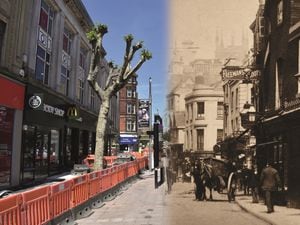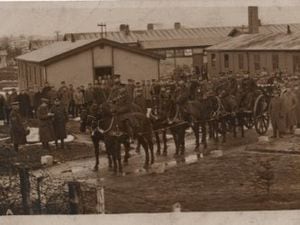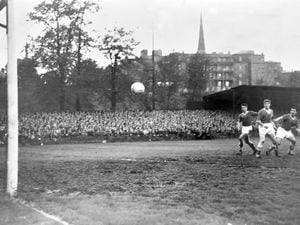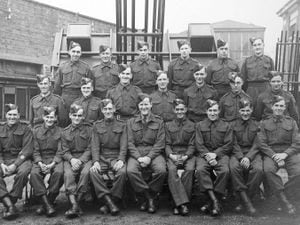Historian reflects on how city has changed
Things aren't what they were, so the saying goes.

High streets packed with thriving independent shops rather than lookalike chain-stores. Close-knit communities of terraced houses where everyone knew their neighbours. Thriving industrial areas which made Britain the workshop of the world.
And a new book, by historian Alec Brew, shows just how Wolverhampton and the surrounding areas have changed over the past 100 years or so.
Alec's new book, Wolverhampton Reflections, captures the changes that have taken place – for better or worse – by superimposing images over the city today on those of how it looked in years gone by.
"It is only by holding up the reflection of what our memory tells us against the image that our eyes can see, that we can tell the extent or not of the change that has taken place," he says.
"In other places it is almost impossible to reconcile what we see today with the images in our memory. Only by placing an old photograph into the modern townscape is it possible to work out where things were."
Alec, who still refers to Wolverhampton as 'the town', despite it having gained city status more than 20 years ago, is a Wulfrunian to his fingertips. Born in Coventry Street, just off the Willenhall Road, he now lives in Claregate, and Wolverhampton Reflections is his 40th book.
He says photographic records are important because the memory has a habit of playing tricks, and there are many areas where the scene today seems exactly as it was in years gone by. Only by juxtaposing pictures from now and then do we see how the areas have truly changed, often much more than we realise.
He says the town has seen many changes over the years.
"It started out as an ordinary market town serving the local countryside, reflected in the cattle market in Cleveland Road and streets such as Farmer’s Fold, which until quite recently led to a small field alongside the dome of the Central Arcade where sheep were kept before market," he says.
"Then in the 18th century it became an industrial town with metal-bashing industries dominating, and large companies like John Thompson's, Bayliss, Jones and Bayliss, Goodyear, ECC, Sunbeam, and Boulton Paul ringing the town."
As these business declined, the town underwent a shopping revolution, with pedestrianisation of Dudley Street and the construction of the Mander and Wulfrun shopping centres.
While this has brought many benefits – Wolverhampton today is much cleaner than it would have been at the height of the Industrial Revolution, and the range of goods on offer would have been unimaginable a century ago – Alec questions whether all the changes have been for the better. And he wonders what the future has in store.
"I think, like most people my age, I would say it has changed for the worse," he says. "It was a very nice town, and now it's in bits and pieces," says Alec, who is 73.
He says the ring road, built during the 1970s and 80s, as being the culprit for much of the decline.
"The ring road destroyed many inner communities and strangled the town centre, where nobody lived anymore," he says.
He says the city's retail trade is now struggling, with the Summer Row shopping development abandoned some years ago, and many shops lying empty.
He observes that the much-loved Beattie's department store moved from its famous building in Victoria Street earlier this year, into the short-lived Debenhams store in the Mander Centre.
"One wonders if another victim of coronavirus will be shopping as we know it," he says.
"As this book was being prepared, the streets of Wolverhampton were largely empty, the most common sight on the roads were parcel company vans delivering the fruits of the online shopping explosion."
The book shows how the main thoroughfares of Dudley Street, Queen Street and Queen Square – which he describes as "tadpole shaped" rather than square – have changed over the years.
Queen Street would be the first sight to greet many visitors to the town as they arrived at the LNWR station.
The landmark Queen's Building, which marked the entrance to the original station, has been preserved, although it looks rather lost today surrounded by the new bus station, and cut off from the railway by the ring road.
Paradoxically, his picture of the bottom of Queen Street, opposite the station, shows how some aspects of the town have perhaps not changed as much as we might think. While we may think of the shopping parade at the corner of Queen Street and Berry Street as just another nondescript postwar building, it actually does bear a striking resemblance to the more imposing building of Victorian Wolverhampton. The new building is of a very similar style and shape, although it has to be said the external finish is much less ornate and pleasing to the eye than the older one. The other buildings in the view are largely unchanged.
At the other end of Queen Street, on the corner with Dudley Street, the changes are very much more pronounced, and it has to be said can scarcely be described as for the better. The intricate Victorian facades have been pulled down to make way for a rather ugly 1960s development.
One building which has thankfully changed very little is the elegant Central Library, which was built in 1902. It was paid for by a public fund sponsored by the mayor in honour of Queen Victoria’s Diamond Jubilee. The buildings on the other side of Garrick Street were demolished to make room for the Wulfrun Centre, which certainly boosted the town as a retail attraction, but did little for the area aesthetically.
Reflecting the growth of Wolverhampton as a retail centre, Dudley Street was pedestrianised in 1973. But Alec points out that it had become a de facto pedestrian zone many years before, with vehicles very much taking second place to the shoppers wandering around the shops. He says the stretch between Queen Street and King Street certainly looked busier in the days of horse-drawn buses than it did in the more recent photograph, taken at the height of the coronavirus pandemic.
This newspaper has recently covered in great detail the changes that have taken place in the North Street area since the 1970s, and this is also reflected in the book.
"The lower part of North Street was lined with very mean housing in Victorian times, but now it’s dominated by university buildings, with the football stadium on the other side of the road," he says.
"Fans and students pass to and from the city centre through the suitably decorated subway under the ring road.
He says North Street used to be named Tup Street, a tup being a male sheep in the days when many of the town’s street names had an agricultural ring to them.
"Leading north from the bottom of Queen Square, the buildings flanking its beginning largely remain the same, including the town hall in the background mist, which is now the Magistrates’ Court."
As its name suggests, North Street was once a major route out of Wolverhampton to the north, but not any more.
"It leads from nowhere to nowhere, from the ring road subway to a dead end at Five Ways Island," he says.
Just off North Street, Molineux Street was previously called Dunster Lane before Molineux House was built, running out into the countryside, but soon encased in more densely packed housing.
One recent change to the city has been the demolition of the old Municipal Tramway Car Depot, built in 1902. It had been extended to house trolleybuses by the time of Alec's 'old' picture, while his 'new' one was taken during the construction of the new YMCA centre and flats along Bilston Road.
A picture of meeting of the Clyno Motor Club opposite the United Service Club on the corner of Humber Road and Great Brickkiln Street is a reminder that Wolverhampton was once a world-famous producer of cars and motorcycles. The cars and motorbikes are facing Pelham Street, where they were made.
"At one time, Clyno was the the third largest car manufacturer in Britain," says Alec.
Again, the site has made way for housing. Clyno closed in 1926 and the United Services Club is now the Tayyaba Mosque.
The book also extends to cover areas such as Willenhall and Bilston, where many old buildings have been retained, but are used for different purposes than they were during the Victorian era.
Despite his belief that the city today isn't what it was, Alec is positive about the future, and believes Wolverhampton still has plenty going for it.
"I look at i54, and I see the factories that have been built there," he says. "We still have some very good companies. Marston's, which used to make the Sunbeam bikes, is still there, it's just part of Collins Aerospace. The Americans bought it because it is a very good company, and it's still going after 275 years.
"We're still making stuff, it's what we do."
*Wolverhampton Reflections by Alec Brew goes on sale on October 15.





